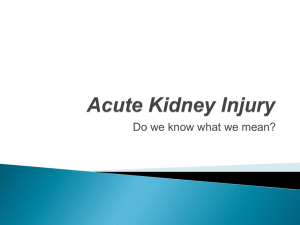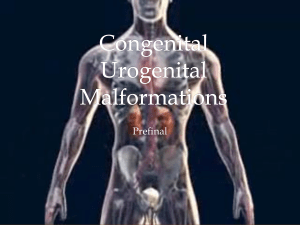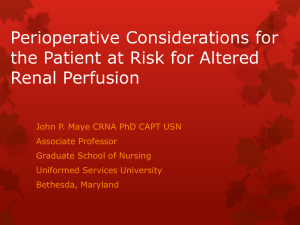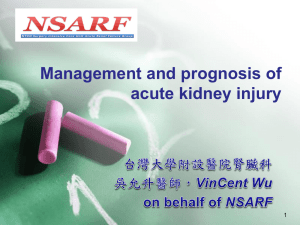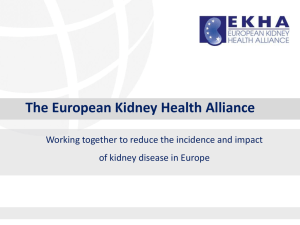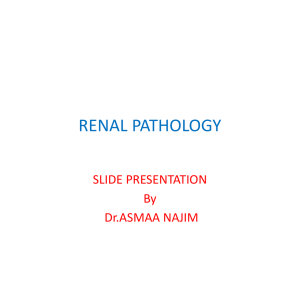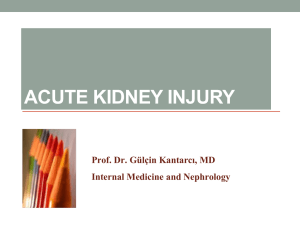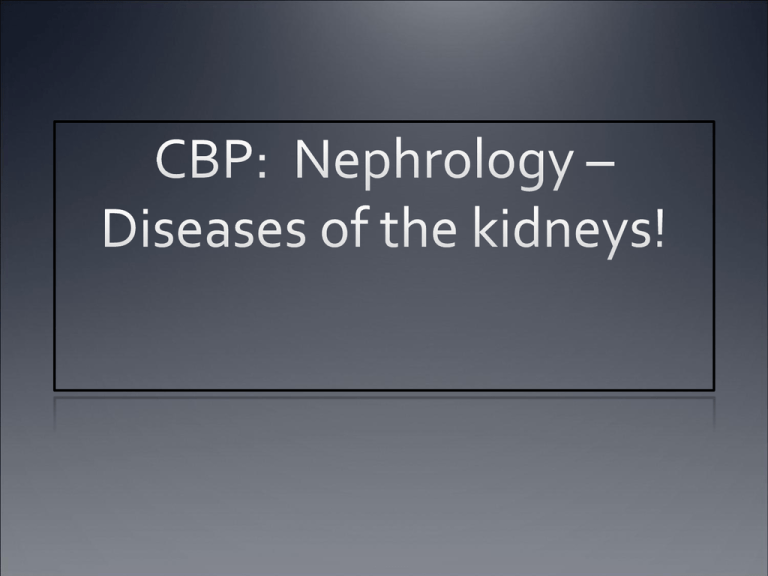
Case Presentation
43 year old gentleman with Crytogenic Cirrhosis is
admitted to the ICU after massive GI bleed secondary to
bleeding esophageal varices. His varices have been
successfully banded and he is admitted post-procedure.
He received multiple units of blood, as well as platelets to
correct his thrombocytopenia and FFP to correct his
coaglulopathy (INR 4.3). He also received 6 L of
crystalloid. He is now hemodynamically stable, however,
his respiratory requirements have increased, in keeping
with his CXR findings of acute pulmonary edema.
PSV, 12/5, FiO2 .45
He is kept intubated over night and given multiple boluses
of Lasix (total of 200mg) to help encourage diuresis.
When assessed in the morning, it is noted that he has been
anuric over night. His admission BUN/Cr were 11/87, and
are now 23/192. He is now on PSV 16/8 and FiO2 is .65.
His electrolytes reveal: Na – 128, K – 5.3, Cl- 97, tCO2 – 18.
ABG: 7.31/39/84/19/-2
Question 1
Briefly describe Hepatorenal syndrome and it’s
pathophysiology. What are some predisposing factors?
(Federico)
DEFINITION
Hepatorenal syndrome is a clinical condition that usually occurs in patients
with advanced liver disease and portal hypertension that is characterized
by :
-Renal failure, with creatinine level more than 1.5mg/dl
-Marked decrease in GFR and renal plasma flow (RPF) in the absence of
other identifiable cause of renal failure.
-Marked abnormality in systemic hemodynamics
-Activation of endogenous vasoactive systems.
HRS occurs predominantly in the setting of cirrhosis, but it may also
develop in other types of severe chronic liver diseases, such as alcoholic
hepatitis, or in acute liver failure .
The theory that best fits with the observed alterations in the renal and
circulatory function in HRS is the vasodilation theory, which proposes that HRS
is the result of the effect of vasoconstrictor systems acting on the renal
circulation and activated as a homeostatic mechanisms to improve the extreme
underfilling of the arterial circulation .That leads to decreased renal perfusion
and glomerular filtration rate (GFR )but tubular function is preserved .
There are two well-differentiated clinical patterns of HRS
Type 1 HRS
•Characterized by rapid and progressive impairment of renal function
defined as a doubling of the initial serum creatinine to a level greater
than 2.5 mg/dl or a 50% reduction of the initial 24-hour creatinine
clearance to a level lower than 20 ml/min in less than 2 weeks .
•Usually occur in severe liver failure (Jaundice, encephalopathy, and
coagulopathy)
•Occur frequently after precipitating factor (e.g. GI bleeding)
•Median survival time is only 2 weeks
Type 2 HRS
•Characterized by a less severe and non-progressive reduction of GFR .
•Associated with relatively preserved liver function.
•The main clinical consequence of this type of HRS is refractory ascites,
due to a lack of response to diuretics .
•Median survival time is about 6 months.
The International Ascites Club has defined criteria for the
diagnosis of HRS. Major criteria, necessary only for the
diagnosis, are as follows:
1.
Low GFR, defined by a serum creatinine greater than 1.5 mg/dL or 24hour clearance lower than 40 mL/min
2.
Absence of shock, ongoing bacterial infection, fluid losses and current
treatment with nephrotoxic drugs
3.
No sustained improvement in renal function (decrease in serum
creatinine to <1.5 mg/dL or increase in clearance to >40 mL/min)
following diuretic withdrawal and plasma volume expansion with
albumin (or 1.5 L of isotonic saline).
4.
Proteinuria less than 500 mg/d
5.
Absence of any evidence of obstructive uropathy or parenchymal
disease as shown by ultrasonography
Precipitating factors
1.
Bacterial infections
2.
Bleeding
3.
Large volume paracentesis without plasma expansion
Patient remains anuric and is given a further bolus of
100mg of Lasix.
Patient remains anuric despite most recent dose of Lasix.
Question 2
Any role for increasing doses of Lasix in an anuric patient?
Any harm? Any benefit? (Federico)
Diuretics in AKI
Regarding
an increased appreciation for the potential
detrimental downstream effects of
volume overload, it may be reasonable to
try diuretics for control of volume overload.
The clinician should, however, be
careful not to delay initiation of RRT for
volume overload in the critically ill patient
with AKI
(Crit.Care 2010, vol 38, n1)
Question 3
Define Acute Kidney Injury (Federico)
RIFLE Criteria
The Acute Dialysis Quality Initiative Group
proposed the RIFLE system classifying ARF into 3 severity
groups and 2 clinical outcome categories
Incidence of AKI in the ICU
AKI occurs in ~ 7% of all hospitalized patients, whereas it
occurs in 36% – 67% of critically ill patients.
On average, 5 % of ICU patients with AKI require renal
replacement therapy.
Dennen P, Douglas IS, Anderson R. Acute kidney injury in the intensive care unit: an update and primer for the intensivist. Crit Care Med. 2010 Jan;38(1):261-75
AKI and mortality
In most studies, mortality rates rise proportionally with severity
of AKI.
Even small increases in serum creatinine have been associated
with increasing mortality in various ICU populations despite
adjusting for severity of illness and comorbidities.
In patients with AKI requiring RRT, mortality rates reach 50% to
70%.
Dennen P, Douglas IS, Anderson R. Acute kidney injury in the intensive care unit: an update and primer for the intensivist. Crit Care Med. 2010 Jan;38(1):261-75
AKI and other outcomes
AKI is also associated with:
Increased length of stay
Increased incidence of CKD and end-stage kidney disease
Increased cost
For example, an increase in SCr of 0.5 mg/dl (38 mmol/L)was
associated with a:
6.5-fold increase in the odds of death
3.5 day increase in LOS
nearly $7500 in excess hospital costs
Dennen P, Douglas IS, Anderson R. Acute kidney injury in the intensive care unit: an update and primer for the intensivist. Crit Care Med. 2010 Jan;38(1):261-75
Chertow GM, Burdick E, Honour M, Bonventre JV, Bates DW. Acute kidney injury, mortality, length of stay, and costs in hospitalized patients. J Am Soc Nephrol. 2005 Nov;16(11):3365-70
Traditional methods for detecting
AKI
Currently available measures do not detect actual kidney
injury the way troponin detects myocardial injury:
Creatinine
Urea
Urine output
Rather they are markers of abnormal renal function, that
can be used to presume kidney inury has occurred.
Bagshaw SM, Bellomo R. Early diagnosis of acute kidney injury. Curr Opin Crit Care. 2007 Dec;13(6):638-44.
Serum creatinine
Used to estimate GFR
Pros
Produced at a relatively constant rate
Freely filtered by glomerulus
Not reabsorbed or metabolized by the kidney.
Bagshaw SM, Bellomo R. Early diagnosis of acute kidney injury. Curr Opin Crit Care. 2007 Dec;13(6):638-44.
Serum creatinine
Used to estimate GFR
Cons
10-40% is secreted by the tubules
Relatively insensitive (may need a 50% reduction in function before
a detectable rise in SCr is seen)
Creatinine production varies based on age/sex/muscle mass/diet
Certain disease states can increase production (rhabdo)
Certain drugs can decrease secretion (cimetidine, trimethoprim)
Certain factorsmay affect assay (ketoacidosis, cefoxitin,
flucytosine)
Does not reflect real-time changes in GFR
Bagshaw SM, Bellomo R. Early diagnosis of acute kidney injury. Curr Opin Crit Care. 2007 Dec;13(6):638-44.
Delay in SCr rise
Waikar SS, Bonventre JV. Creatinine kinetics and the definition of acute kidney injury. J Am Soc Nephrol. 2009 Mar;20(3):672-9
Urea
Rate of production is not constant
Increases with protein intake
Increases in critical illness (burns/sepsis/trauma)
GI Bleed
Steroids
40% - 50 % of urea is reabsorbed by the kidney (even more
when dry)
Bagshaw SM, Bellomo R. Early diagnosis of acute kidney injury. Curr Opin Crit Care. 2007 Dec;13(6):638-44.
Urine output
Pros
A dynamic gauge of kidney function.
May be a barometer for change in kidney perfusion
Cons
Poor sensitivity and specificity
Can have severe AKI with normal or increased urine output
Bagshaw SM, Bellomo R. Early diagnosis of acute kidney injury. Curr Opin Crit Care. 2007 Dec;13(6):638-44.
Novel methods for detecting AKI
Serum Cystatin C
Kidney injury molecule-1
Neutrophil gelatinase-associated lipocalin (NGAL)
Urinary IL-18
Serum cystatin c
An endogenous cysteine proteinase inhibitor
Synthesized at a relatively constant rate
Released into plasma by all nucleated cells in the body
Knight EL, Verhave JC, Spiegelman D, et al. Factors influencing serum cystatin C levels other than renal function and the impact on renal function measure- ment. Kidney Int 2004; 65:1416–1421
Serum cystatin c
Reportedly not affected by patient age, sex, muscle mass or
diet
However, one large study showed that age, sex, height, weight,
smoking status, and CRP levels were all associated with cystatin
c levels.
Also found to be affected by abnormal thyroid function,
immunosuppression (steroids), and systemic inflammation
Knight EL, Verhave JC, Spiegelman D, et al. Factors influencing serum cystatin C levels other than renal function and the impact on renal function measure- ment. Kidney Int 2004; 65:1416–1421
Serum cystatin c
Almost 99% is filtered by the glomerulus
Not secreted or reabsorbed by the tubules
Therefore a rise in cystatin c is a good indication of a
decrease in GFR
Bagshaw SM, Bellomo R. Early diagnosis of acute kidney injury. Curr Opin Crit Care 13:638–644.
Serum cystatin c
Cystatin C-based estimates of GFR may perform better in those with
lower SCr concentrations such as:
Elderly patients
Children
Renal transplant recipients
Cirrhotics
Those that are malnourished
May be more sensitive to early and mild changes of kidney function
compared with creatinine
Bagshaw SM, Bellomo R. Early diagnosis of acute kidney injury. Curr Opin Crit Care 13:638–644.
Kidney injury molecule-1
A transmembrane glycoprotein that is normally minimally
expressed in kidney tissue.
Shows marked upregulation in proximal renal tubular cells
in response to ischemic or nephrotoxic AKI
Shed from proximal cells and detected in the urine by
immunoassay
Bagshaw SM, Bellomo R. Early diagnosis of acute kidney injury. Curr Opin Crit Care 13:638–644.
Kidney injury molecule-1
Urinary levels of KIM-1 are significantly higher in
established AKI compared with other causes of AKI (i.e.
PRA, contrast-induced nephropathy) or CKD.
Thus, KIM-1 may represent an early, noninvasive
biomarker for proximal tubular AKI.
More studies needed to define its role
Bagshaw SM, Bellomo R. Early diagnosis of acute kidney injury. Curr Opin Crit Care 13:638–644.
Neutrophil gelatinase-associated
lipocalin (NGAL)
Belongs to the lipocalin superfamily
Markedly upregulated in response to kidney ischemic or nephrotoxic injury
May be an early and sensitive urinary biomarker of ischemic and nephrotoxic AKI.
Early elevations in urinary NGAL after kidney transplan- tation have been shown
to be predictive of:
delayed graft failure
Need for RRT during the first week following transplantation
Bagshaw SM, Bellomo R. Early diagnosis of acute kidney injury. Curr Opin Crit Care 13:638–644.
Interleukin-18
IL-18 can be induced in the proximal tubule and detected
in the urine in ischemic AKI
Is increased in the urine of patients with established AKI
when compared to those with prerenal failure, urinary
tract infection, CKD or healthy controls.
Elevated urinary IL-18 values have been shown to
preceded clinical evidence of overt AKI (50% increase in
SCr) by 24 – 48 h in critically ill patients with ARDS.
Urinary IL-18 values of at least 100pg/ml were associated
with an estimated 6.5 increased odds of developing AKI
within 24 h.
Bagshaw SM, Bellomo R. Early diagnosis of acute kidney injury. Curr Opin Crit Care 13:638–644.
Summary of novel markers
Bagshaw SM, Bellomo R. Early diagnosis of acute kidney injury. Curr Opin Crit Care 13:638–644.
Question 5
What are some traditional and novel methods for early
detection of kidney injury? (Marios)
Patient continues to have increasing ventilation support
requirments and is now on .85 FiO2. His K+ is now 5.6. He
is given routine hyperK+ therapy. He has been started on
vasopressors because of declining MAP
Question 6, 7
What are the indications for CRRT vs IHD. Is one better?
What are their associated advantages and disadvantages?
(Neil)
When should RRT be initiated?
A,E,I,O,U
CRRT review Chest 2007
Acute Renal Failure Lancet review.pdf
Bouman et al.TimingofCRRT-CurrOpCritCare2007.pdf
CRRT review Chest 2007
Lameire et al. Lancet 2005
CRRTvsIHDCochrane2007.pdf
Question 8
Define the different modes of CRRT. Use a diagram to
highlight the differences? (Noemie)
It is decided to start the patient on CRRT therapy. What
kind of anticoagulation should he receive?
Question 9
Compare the different modes of anticoagulation.
Explain the use of citrate and how to dose it. Please explain
the calcium gap. (Noemie)
Anticoagulation
Heparin
Can be given systemically or through circuit
Aim for PTT 35-45 sec
Regional citrate
Intensive Care Med 2004;30:260-265
Kidney International 2005;67:2361-2367
Intensive Care Med 2004;30:260-265
Kidney International 2005;67:2361-2367
Anticoagulation
Citrate
Citrate infusion pre-filter
Leads to calcium chelation and clotting time
Aiming for post filter iCa btw 0.25-0.35
Post-filter calcium infusion to restore systemic Ca and
clotting function
Citrate
Concerns:
Pricy
Operator training + time consuming
Repeat labs q6h: Post filter iCa, Systemic iCa and total Ca
Risk of hypocalcemia
Calcium
Total plasma Calcium:
40% bound to albumin
45% circulates as ionized calcium
15% bound to organic/inorganic anions
Citrate and Calcium Gap
50% of citrate cleared through dialyser
Remaining citrate metabolized in the liver to Bicarbonate
If citrate systemic delivery >> pt’s ability to metabolize
citrate
Systemic accumulation of Calcium Citrate hypocalcemia
Calcium gap
Calcium gap: Total calcium - ionized Ca
Citrate accumulation causes Total calcium and iCa
Pt with acute renal failure and liver failure are at increased
risk of citrate accumulation
Tidbits from Dodek
Citrate toxicity, only clinically relevant if:
Leads to hypernatremia
Leads to metabolic acidosis (when citrate is not metabolized,
b/c it is an acid)
+/- Metabolic acidosis (because it is converted to HCO3)
Hypocalcemia (but just turn up your Ca infusion)
In relation to above, calcium gap not all that relevant
Question 10
What is an ideal dialysis dose? (Todd)
What is the ideal dialysis dose?
I don’t know.
And I’m not the only one.
Speaking of flashbacks…
2 recent studies addressing the issue of “dose” of renal
replacement therapy
The first included multiple RRT modalities…
IHD, SLED, CVVHDF
Patients enrolled had ATN requiring dialysis and either sepsis
or one additional nonrenal organ failure
Excluded patients with chronic kidney disease
CVVHDF dose was 20 cc/kg/hr in the less intensive group and
35 cc/kg/hr in the intensive group
In the IHD/SLED patients, dosing was 3 times per week or 6
times per week, respectively
Essentially no difference
Mortality, recovery of renal function, ICU-free days, organ
failure scores, or discharge home without dialysis.
The second rule of (city wide)
Journal Club…
Critically ill patients with AKI requiring dialysis
Excluded if on dialysis pre-admission
CVVHDF, with post-filter replacement fluid
25 cc/kg/hr vs 40 cc/kg/hr
Dialysate: replacement fluid (Hmosol B0) 1:1
What does this mean…?
That the dose is unimportant? That the dose beyond a (not quite
determined) value is not important? Are we looking for the wrong
outcomes?
What box should I check?
At RCH: 35 cc/kg hr (as opposed to 45)
Saves a few bucks on dialysis/replacement fluid.
Question 11
It turns out the patient has been feeling very suicidal
lately
What are the indications for RRT in acute intoxications
(Todd)
What are the indications for RRT
in acute intoxications?
If there is indication of severe toxicity
If elimination can be improved by an extracorporeal
technique.
HD, HF, hemoperfusion, MARS
Current Opinion in Critical Care 2007, 13:668–
673
Dialysis techniques: Discussed already.
Hemoperfusion: adsorption of toxins
MARS: hemoperfusion technique using albumin
exchanger.
Or hemofiltration
And possibly: Carbamazapine, diltiazem, phenytoin and mushrooms
Patient stabilized on CRRT therapy and slowly his renal
function has shown some improvements with production
of small amounts of urine. His hemoglobin has remained
stable and HD he is off pressors. However, you are called
to his bed side stat as his BP has suddenly dropped. His
repeat HgB shows a drop of 35. You are entertaining a
retroperitoneal bleed and want to do a CT contrast of his
abdo/pelvis.
Question 12
Does RRT decrease the incidence of Contrast induced
nephropathy? (Todd)
decrease the incidence of
contast-induced nephropathy?
It should. But there’s no evidence that it does.
One trial randomized patients to low-dose hemofiltration in
ICU vs ward care with NS at 1cc/kg/hr, prior to PCI and found
no difference in CIN or mortality. Duration was approx. 6
hours pre- and 20 hours post- contrast load.
58 pts per group, average Cr 270.
Other strategies, i.e. iso-osmolar contrast, NAC, were included
PRISMA geeks rejoice…
Femoral HD line
Pump speed 100 cc/min
Replacement fluid at 1000 cc/hr
No net fluid off
Heparin anticoagulation
The fine print
Control group needed more renal replacement therapy
(25% vs 3% in intervention group)
The end!
You now know all about the kidneys!!!

